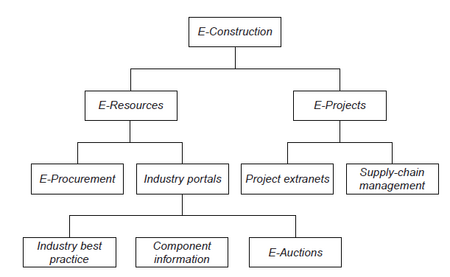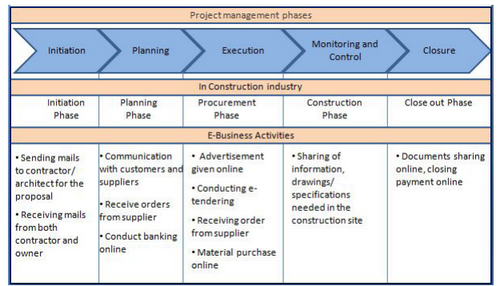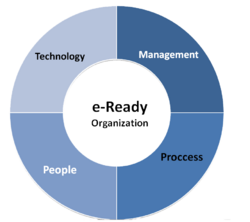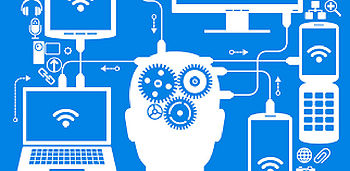E-construction and ICT
Developed by Nikolaj Skafte Koch
The construction industry has undergone enormous changes since 1990, due to the growth of the internet, which changed the information flows on construction projects. These changes are grouped under the term e-construction.
E-construction is the use of electronic technology or information and communication technology (ICT) to change traditional processes. The evolution of ICT in the recent years has changed the process of information creation, storage and access. Through fixed ICT agreements the optimal foundation for digital collaboration in the project is created. These terms are defined when the project agreements between the client and consultant are established, but can be subjected to updates during the project lifetime.
A specific tool in the form of BIPS’ A102 - ICT specification tool will be examined. This tool yields the basis for the different parties in a construction project to compose terms of reference for classification, digital communication, communication platform, digital project design, digital tendering, quantities and digital handover. Different models in the specification tool will be presented corresponding to varying demands towards ICT from the client.
In the end, the limitations of the ICT specifications and eventual improvements required for success and the future of the ICT specifications will be outlined.
Contents |
The Big Idea

Generally, e-business can apply to every industry, but the implementation of e-business in the construction industry is defined as the conduct of construction business by electronic means. The applications of e-construction fall into two broad fields.
- E-resources: Pre-contract business - search for resources in the form of people, components and suppliers.
- E-projects: post contract business – Managing project information flows or the supply chain.
The subcategories include e-procurement, e-portals, project extranets and supply-chain management.
- E-procurement is the use of information and communication technologies to conduct digital tendering, which normally follows a reverse auction system.[1] The e-procurement makes it possible for the client to send out project specifications digitally and for the participants in the tendering process to submit their proposals digitally.
- E-portals is the creation of databases containing suppliers of people or components, which makes it easier for the client to find and invite relevant suppliers to the given project. These portals also make it possible for the suppliers to advertise services, which may otherwise be unknown to the client.
- Project extranets utilize the information and communication technologies in improving the interactions and collaboration between the different members of the project coalition. This includes digital distribution of drawing material and documentation between the members with 24/7 availability and with version control implemented, whereby the member responsible for changes are tracked. This process is made easier with the introduction of Building information models, where the models contains a full 3d model from which the drawing material can be extracted and documentation of the included components in the form of material, geometrical and economical properties etc.
- Supply-chain management will not be discussed further in this article.

The e-construction activities can be related to the general phases of project management, where the e-construction activities can be concluded relevant in every phase of the project management as every piece of information can be transferred trough information and communication tools, which lessen the required physical material and repetitive delivery times.
The implementation of e-business in the construction industry has been relatively inefficient compared to other engineering sectors as for example the automotive or the aerospace industry.[3] The main reasons for this inefficiency is the fragmented structure of the construction industry, where a lot of practitioners needs to collaborate during a given project, and the uniqueness of a construction project. The construction of a building cannot be done with the use of an assembly line as each project requires specific components.
To mitigate this inefficient utilization of e-business in the construction industry regulations needs to be implemented, which can be specified separately for each project. These regulations should thereby optimize each e-construction activity if followed accordingly by the different members of the project coalition.
Application
The implementation and utilization of information and communication technologies in construction is legally regulated differently from country to country. The regulations for the digital construction in Denmark is defined in the ICT-declarations for public and general construction [4] [5], which is a compilation of general requirements for the use of ICT in a construction project.
The construction knowledge center MOLIO [6] has sought a way of defining the ICT-declarations in a simple and clear format, easy to read for the different parties in the construction industry, who not necessarily has advanced knowledge of law. This process has resulted in the newest release of the ICT-specification tool: A102 ICT-specifications 2016. The specification is created in a wide collaboration with the construction industry in the form of user groups, competent feedback, test panels etc. [7]
The purpose of the A102 ICT-specifications 2016 is to support different parties in a construction project specifying and contracting the required ICT service, which should ease the digital collaboration and prevent responsibility issues. The ICT services are separated into the following seven categories, which should all be specified:[8]
| Category | Specifications |
|---|---|
| Classification | The purpose and extent of the use of classification and identification is specified. Classification and identification should as a minimum be specified in tender lists, building models and tender documents. Furthermore, the classification system and identification method is to be specified. Ref: CCS etc. |
| Digital Communication | The platform for communication and file sharing is specified, where standardized platforms and file formats should be preferred for the benefit of the entire organization. Furthermore, the general folder structure and metadata used for identification, is to be specified |
| Establishing a communication platform | The party responsible for the communication platform and the maintenance of it is specified. Furthermore, the administrator of the system is appointed. |
| Digital project design | General structure and features of the project design model is specified. Additionally, the general layout of drawings in the form of layer structure, the drawing/font sizes and the file format for sharing. In this step, the reference system is also placed fixed to a predetermined reference point, which indicates the construction projects initial point. |
| Digital tendering | The responsible and administrator of the tendering portal is appointed. Furthermore, the layout of the tender material is specified together with the required file format for the specific parts of the project material. |
| Quantities | It is here specified if quantities are part of the tender material and if yes, to which extent these quantities are specified. Furthermore, it is specified how the quantities are obtained and how these are presented either in the project design model or in separate schedules. |
| Digital handover | It is here specified which parties are responsible for the separate parts of the final project material. Additionally, the necessary degree of quality assurance for both the extent and quality of the material is specified. |
Introduced in the newest release: A102 ICT-specifications 2016, as a further help to filling the ICT-specification predefined project models was introduced. The purpose of these models was to help the parties create a precise and realistic foundation for the project delivery, which should help both the experienced and not so practiced client. The following three models can be used:
| Model | Description |
|---|---|
| A | A predefined model created based on the general procedures used by the individual companies in the construction industry. The model is used, when client don’t have specific requirements to the ICT services extending the requirements specified in the ICT-declaration. Due to the simplicity of this model, the consultants have a high degree of freedom choosing the work method. |
| B | A predefined model created based on the standards and tools from MOLIO. As many predefined methods, as possible are used. By choosing this model the client also fulfills the requirements of the ICT-declaration as it will be the model, which has most mutual standards from the industry implemented. |
| P | A project specific model used if the client has specific requirements or wishes for the ICT services. It is the client’s responsibility to implement these requirements in the ICT specification, which is normally done by taking offset in either model A or B and applying/removing the wished changes. |
This provides a template for establishing the ICT specification for the project, which follows the nationally specified ICT regulations. The ICT specifications can either be completed in the paradigm provided by MOLIO or created in a document or spreadsheet by the project parties themselves by following the previously mentioned specifications. The paradigm from MOLIO is an editable document in which the client and contractor in a simple way can remove or add the wished specifications, still considering that the predefined modes cannot be edited, if these are chosen.
The final agreement of the ICT specifications is included as an appendix of the project specification, which the client and contractor then legally sign and thereby must follow during the project lifetime.
Limitations

A big obstacle in the utilization of information and communication technologies is the implementation of these technologies for the different parties in the project coalition and determining if these are ready to the transition.
Several publications indicate that the key aspects for successful implementation of information and communication technologies can be compiled in the aspects: people, process and technology. However, the three aspects need a leading fourth aspect to work in combination, which in the case of construction projects is management. [3]
Determining organizational readiness for e-construction can thereby be performed through the verdict model, which compiles the four aspects, where the 4 points can be defined by:
- Management believing in the technology and driving towards its adoption, implementation and usage to receive business benefits through the implementation of the technology.
- Processes that make it possible to successfully adopt the technology and supports the implementation.
- People with the necessary knowledge, skills and belief relative to the technology.
- Technology electronic infrastructure required to support full implementation and utilization of the business functions (e.g. the processes and people).
If the four required aspects for organizational readiness for e-construction is fulfilled. The wished information and communication tools can be implemented and utilized.
Some milestones creating a paradigm shift in the construction industry, which required updating of the processes and people aspects can be found in the tools for creating drawing material. Before the personal computer emerged, technical drawings were made by hand. The personal computer in the 1980s helped the computer aided design (CAD) gaining market share, which changed the requirements for the work processes in the creation of drawings and new people with expert knowledge in CAD software. The same was the case when the marked with the transition from CAD to building information modelling (BIM), which changed how the project information flow could be handled simultaneously with the generation of drawing material through advanced 3-dimensional building models.
Some of the advantages and challenges of the implementation and utilization of information and communication technologies in the construction industry is compiled in the following table:[3]
| Advantages | Challenges |
|---|---|
| Service/product promotion:
Reduction in advertisement and marketing cost as the relevant target audience for the given services/products can be found efficiently. e-procurement: Construction search engines can be used to efficiently to find optimal suppliers of services. Simplified procurement process, where the exchange of tender documents is easily processed. Online project collaboration: Online collaboration tools, easy project information flow as the data can be accessed anywhere anytime by anyone from the project coalition. Additionally, this yields better collaboration, time savings and project cost savings. General: Reduce paperwork, reduce repetitive tasks (fewer errors) and provide a wider market reach as it no longer matters in which locations the project members are. |
Trust and reliability:
Confidentiality regarding work is required as data is secret. Knowledge of possible compromises. The knowledge of secret data could undermine the whole purpose of the competitive tendering. Regulatory issues: Unclear regulatory issues in the use of ICT in construction. Sought fixed in Denmark with the legal ICT regulations. Needs to be simple as the time used for legal issues, could exceed the eventual benefits of utilization of the technology. Information management systems: Information overflow due to the number of different practitioners in the construction industry. When needing data for a specific contractor, it can disappear in the information flow, due to the increase of collaboration tools. Human resources: The organization could not possess the required skills to manage the new communication or information technology. Could be solved by creating a stricter formulation of the verdict model, which the organization could follow before initiating the use of new technologies. |
Cases
- Renovation at University of Copenhagen: General problems with the sharing of building information models between the contractors as the mutual file format didn’t work as intended. This was due to minimal effort initially employed in the creation of the ICT specifications between the contractors these specifications were revised mid-project and ended being a very costly process.[9]
- Municipality of Gentofte: Utilize the ICT specification consistent with construction project being supplied digitally, administration through projectweb and documentation in 3D. Recommend the A102 ICT-specifications as they are easy to use, when understood. But enables the possibility of reusing the ICT specifications for similar projects with minimal modification effort.[10]
Annotated Bibliography
Chimay J. Anumba and Kirti Ruikar (2008), “e-Business in Construction”, 1. edition, Wiley-Blackwell.
Defining general e-business and the specific branch in the construction context indicated by the name E-construction. The book is grouped in four areas: introduction of e-business in a construction context, technological support for e-business in construction, socio-technical issues in e-business and industrial case studies in the US. The book is concluded by the benefits of e-business in construction, the considerations and barriers in implementation and the expected future of e-construction.
Young Jie Chen (2012), “Strategic implications of e-business in the construction industry”, Langborough University.
A doctoral thesis examining the implementation of e-business in the construction industry. The work is supported by a general introduction to the research methodology and containing industry surveys and case studies from which the succes of implementation and utilization of e-business is evaluated.
S. Perera et al. (2017) “Advances in construction ICT and e-business”, 1. edition, Routledge.
Presenting advances in e-procurement and how these can be related to the concept of building information modelling with practical cases. Furthermore the development of project extranets for project collaboration by collaborative tools is evaluated. The work is completed with a status quo and an assumption of future trends is presented.
References
- ↑ 1.0 1.1 Graham M. Winch (2010), “Managing construction projects”, 2. edition, Wiley-Blackwell.
- ↑ T. M. Cherian & L. A. Kumaran (2016) "E-Business in Construction Industry: Opportunities and Challenges." http://www.indjst.org/index.php/indjst/article/viewFile/98655/72747
- ↑ 3.0 3.1 3.2 Chimay J. Anumba and Kirti Ruikar (2008), “e-Business in Construction”, 1. edition, Wiley-Blackwell.
- ↑ Regulations about the utility of information and communication technology (ICT) in public construction. https://www.retsinformation.dk/forms/R0710.aspx?id=145421
- ↑ Regulations about the utility of information and communication technology (ICT) in general construction. https://www.retsinformation.dk/forms/R0710.aspx?id=144517
- ↑ Danish Construction Knowledge Center. https://molio.dk/
- ↑ New operational ICT specifications has been published. https://bips.dk/nyhed/nye-operationelle-ikt-specifikationer-er-udkommet
- ↑ A102 ICT specifications 2016 https://bips.dk/v%C3%A6rkt%C3%B8jsemne/a102-ikt-specifikationer-2016#0.
- ↑ Stig Neumann. Universitetsrenovering kaster guldkorn af sig. https://bips.dk/files/universitetsrenovering_kaster_goldkorn_af_sig.pdf
- ↑ Poul Høegh Østergaard. Gentofte henter gevinster ved IKT. https://bips.dk/files/gentofte_og_ikt-specifikationerne.pdf
